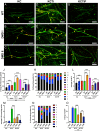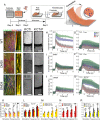Prednisolone rescues Duchenne muscular dystrophy phenotypes in human pluripotent stem cell-derived skeletal muscle in vitro
- PMID: 34260377
- PMCID: PMC8285911
- DOI: 10.1073/pnas.2022960118
Prednisolone rescues Duchenne muscular dystrophy phenotypes in human pluripotent stem cell-derived skeletal muscle in vitro
Abstract
Duchenne muscular dystrophy (DMD) is a devastating genetic disease leading to degeneration of skeletal muscles and premature death. How dystrophin absence leads to muscle wasting remains unclear. Here, we describe an optimized protocol to differentiate human induced pluripotent stem cells (iPSC) to a late myogenic stage. This allows us to recapitulate classical DMD phenotypes (mislocalization of proteins of the dystrophin-associated glycoprotein complex, increased fusion, myofiber branching, force contraction defects, and calcium hyperactivation) in isogenic DMD-mutant iPSC lines in vitro. Treatment of the myogenic cultures with prednisolone (the standard of care for DMD) can dramatically rescue force contraction, fusion, and branching defects in DMD iPSC lines. This argues that prednisolone acts directly on myofibers, challenging the largely prevalent view that its beneficial effects are caused by antiinflammatory properties. Our work introduces a human in vitro model to study the onset of DMD pathology and test novel therapeutic approaches.
Keywords: Duchenne muscular dystrophy; dystrophin; myogenesis; myopathy; pluripotent stem cell.
Conflict of interest statement
Competing interest statement: O.P. and J.C. are founders and shareholders of Anagenesis Biotechnologies. R.B.-D. and E.N.O. are consultants for Exonics Therapeutics/Vertex Genetic Therapies. A.E.C. is a cofounder and Scientific Advisory Board member of Q-State Biosciences. K.K.P. is a shareholder of Emulate.
Figures





References
-
- Brenman J. E., Chao D. S., Xia H., Aldape K., Bredt D. S., Nitric oxide synthase complexed with dystrophin and absent from skeletal muscle sarcolemma in Duchenne muscular dystrophy. Cell 82, 743–752 (1995). - PubMed
Publication types
MeSH terms
Substances
Grants and funding
LinkOut - more resources
Full Text Sources

